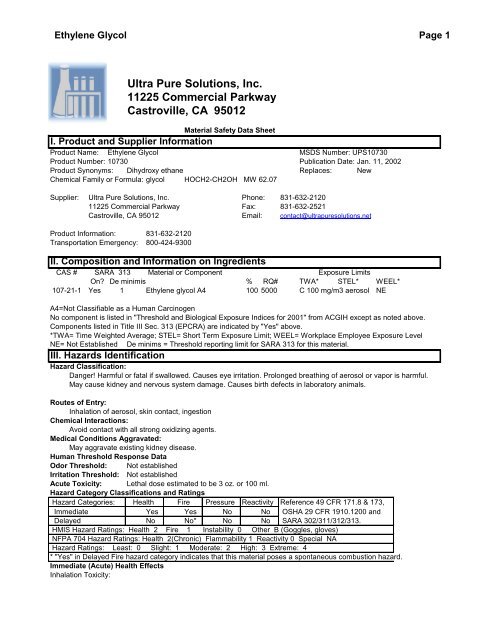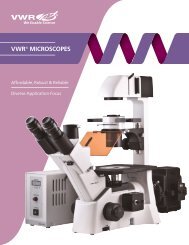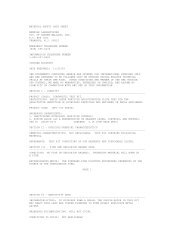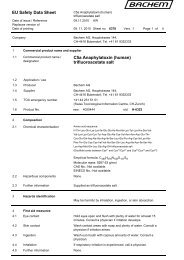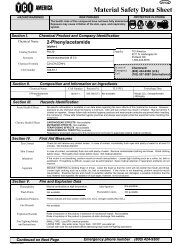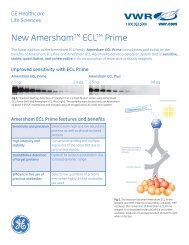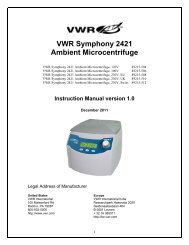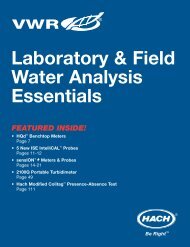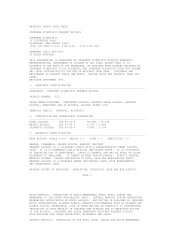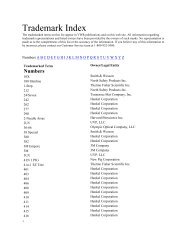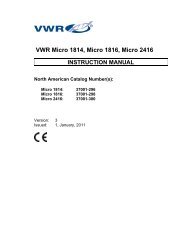Ultra Pure Solutions, Inc. 11225 Commercial Parkway Castroville ...
Ultra Pure Solutions, Inc. 11225 Commercial Parkway Castroville ...
Ultra Pure Solutions, Inc. 11225 Commercial Parkway Castroville ...
Create successful ePaper yourself
Turn your PDF publications into a flip-book with our unique Google optimized e-Paper software.
Ethylene Glycol Page 1<br />
<strong>Ultra</strong> <strong>Pure</strong> <strong>Solutions</strong>, <strong>Inc</strong>.<br />
<strong>11225</strong> <strong>Commercial</strong> <strong>Parkway</strong><br />
<strong>Castroville</strong>, CA 95012<br />
Material Safety Data Sheet<br />
I. Product and Supplier Information<br />
Product Name: Ethylene Glycol MSDS Number: UPS10730<br />
Product Number: 10730 Publication Date: Jan. 11, 2002<br />
Product Synonyms: Dihydroxy ethane Replaces: New<br />
Chemical Family or Formula: glycol HOCH2-CH2OH MW 62.07<br />
Supplier: <strong>Ultra</strong> <strong>Pure</strong> <strong>Solutions</strong>, <strong>Inc</strong>. Phone: 831-632-2120<br />
<strong>11225</strong> <strong>Commercial</strong> <strong>Parkway</strong> Fax: 831-632-2521<br />
<strong>Castroville</strong>, CA 95012 Email: contact@ultrapuresolutions.net<br />
Product Information: 831-632-2120<br />
Transportation Emergency: 800-424-9300<br />
II. Composition and Information on Ingredients<br />
CAS # SARA 313 Material or Component Exposure Limits<br />
On? De minimis % RQ# TWA* STEL* WEEL*<br />
107-21-1 Yes 1 Ethylene glycol A4 100 5000 C 100 mg/m3 aerosol NE<br />
A4=Not Classifiable as a Human Carcinogen<br />
No component is listed in "Threshold and Biological Exposure Indices for 2001" from ACGIH except as noted above.<br />
Components listed in Title III Sec. 313 (EPCRA) are indicated by "Yes" above.<br />
*TWA= Time Weighted Average; STEL= Short Term Exposure Limit; WEEL= Workplace Employee Exposure Level<br />
NE= Not Established De minims = Threshold reporting limit for SARA 313 for this material.<br />
III. Hazards Identification<br />
Hazard Classification:<br />
Danger! Harmful or fatal if swallowed. Causes eye irritation. Prolonged breathing of aerosol or vapor is harmful.<br />
May cause kidney and nervous system damage. Causes birth defects in laboratory animals.<br />
Routes of Entry:<br />
Inhalation of aerosol, skin contact, ingestion<br />
Chemical Interactions:<br />
Avoid contact with all strong oxidizing agents.<br />
Medical Conditions Aggravated:<br />
May aggravate existing kidney disease.<br />
Human Threshold Response Data<br />
Odor Threshold: Not established<br />
Irritation Threshold: Not established<br />
Acute Toxicity: Lethal dose estimated to be 3 oz. or 100 ml.<br />
Hazard Category Classifications and Ratings<br />
Hazard Categories: Health Fire Pressure Reactivity Reference 49 CFR 171.8 & 173,<br />
Immediate Yes Yes No No OSHA 29 CFR 1910.1200 and<br />
Delayed No No* No No SARA 302/311/312/313.<br />
HMIS Hazard Ratings: Health 2 Fire 1 Instability 0 Other B (Goggles, gloves)<br />
NFPA 704 Hazard Ratings: Health 2(Chronic) Flammability 1 Reactivity 0 Special NA<br />
Hazard Ratings: Least: 0 Slight: 1 Moderate: 2 High: 3 Extreme: 4<br />
* "Yes" in Delayed Fire hazard category indicates that this material poses a spontaneous combustion hazard.<br />
Immediate (Acute) Health Effects<br />
Inhalation Toxicity:
Ethylene Glycol Page 2<br />
Harmful if inhaled or swallowed. May produce nausea, vomiting, headache, dizziness and irregular eye movements<br />
Inhalation Irritation:<br />
Irritation of nose and throat.<br />
Skin Contact:<br />
No evidence of harmful effects from available information.<br />
Skin Absorption:<br />
No evidence of harmful effects from available information.<br />
Eye Contact<br />
Causes eye irritation with tearing, pain or blurred vision.<br />
Ingestion Irritation:<br />
May cause abdominal discomfort or pain. Effects extend to cardiac failure, pulmonary edema,and severe kidney<br />
damage. May be fatal.<br />
Ingestion Toxicity:<br />
Causes diarrhea, nausea, vomiting. May be fatal.<br />
AcuteTarget Organ Toxicity:<br />
Kidney damage.<br />
Prolonged (Chronic) Health Effects<br />
Carcinogenicity:<br />
This product is not known or reported to be carcinogenic by any reference source including IARC, OSHA or<br />
NTP, or ACGIH.<br />
Reproductive and Developmental Toxicity:<br />
None observed in animal studies. None reported in humans.<br />
Sensitization:<br />
Undiluted material may cause sensitization in rare cases.<br />
Inhalation:<br />
Prolonged or repeated exposure may produce symptoms of CNS involvement, particularly dizziness and nystagmus<br />
Skin Contact:<br />
Prolonged or repeated skin exposure will aggravate symptoms described above.<br />
Skin Absorption:<br />
Reported effects from chronic exposure include damage to kidneys, liver and CNS.<br />
Ingestion:<br />
Chronic ingestion unlikely.<br />
General :<br />
Prolonged or repeated exposure may cause eye, liver, kidney or lung damage.<br />
Chronic Target Organ Toxicity:<br />
Primarily kidney damage.<br />
Supplemental Health Hazard Information:<br />
No additional health information available.<br />
IV. First Aid<br />
Inhalation:<br />
Remove individual to fresh air. Get medical attention if symptoms persist.<br />
Skin Contact:<br />
Flush skin with water for 15 minutes and remove contaminated clothing. Wash clothing before reuse.<br />
Eyes:<br />
Immediately flush eyes with plenty of water for several minutes. Remove contact lenses. Seek medical attention.<br />
Ingestion:<br />
Immediately seek medical attention. Give two glasses of water to fully concious patient. Do NOT induce vmiting.<br />
If patient has swallowed a few ounces, give 3-4 ounces of hard liquor (whiskey). Give proportionately less to<br />
children.<br />
V. Fire Fighting Measures<br />
Flammability Summary (OSHA):<br />
Flammable<br />
Flammable Properties:
Ethylene Glycol Page 3<br />
Flash Point 116C, 241F CC 116C, 240F OC<br />
Autoignition Temperature:<br />
400C, 752F<br />
Upper Flammable/Explosive Limit, % in a 15.3<br />
Lower Flammable/Explosive Limit, % in a 3.2<br />
Fire/Explosion Hazards Flammable liquid. Vapor can travel distances to ignition sources and flash back.<br />
OSHA Class II Combustible Liquid. Follow appropriate National Fire Protection Association (NFPA) codes.<br />
Hot organic chemical vapors or mists are susceptible to sudden spontaneous combustion when mixed with air.<br />
Ignition may occur at temperatures below published autoignition or ignition temperatures. Ignition temperatures<br />
decrease with increasing vapor volume and vapor/air contact time and are influenced by pressure changes.<br />
Ignition may occur at typical elevated temperature process conditions, especially in processes operating<br />
under vacuum if subjected to the sudden ingress of air, or with sudden escape of hot vapors into outside air.<br />
Extinguishing Media:<br />
Water spray or foam for large fires. CO2 or dry chemical for sma;ll fires.<br />
Do not allow contaminated water to enter sewers or waterways.<br />
Fire Fighting Instructions:<br />
In case of fire, use normal fire fighting equipment including a NIOSH approved self-contained breathing<br />
breathing apparatus (SCBA). Use water to cool containers. Decontaminate equipment before returning to service.<br />
Hazardous Combustion Products:<br />
Oxides of carbon.<br />
VI. Accidental Release Measures<br />
Personal Protection for Emergency Situations:<br />
Evacuate the area of all unnecessary personnel.<br />
Contain the release and eliminate its source if this can be done safely. Report according to all relevant regulations.<br />
Spill Mitigation Procedures<br />
Air Release:<br />
Low vapor pressure makes air release unlikely to present a hazard.<br />
Water Release:<br />
This material is soluble in water. Contain all liquid for treatment and/or disposal as a (potential) hazardous<br />
waste. Notify all downstream users of possible contamination.<br />
Land Release:<br />
Create a dike or trench to contain materials. Absorb spill with inert material (e.g., dry sand, clay, earth or<br />
commercial absorbent), then place in a chemical waste container. Decontaminate all clothing and the<br />
spill area using a detergent and flush with large amounts of water. Contain all contaminated water for<br />
disposal and/or treatment.<br />
Additional Spill Information:<br />
Stop source of spill as soon as possible and notify appropriate personnel. Utilize emergency response<br />
personal protection equipment prior to the start of any response. Evacuate all non-essential personnel.<br />
Dispose of spill residues per guidelines under Section XIII, Disposal Considerations.<br />
VII. Handling and Storage<br />
Handling:<br />
Keep container closed. Use with adequate ventilation. Wash thoroughly after handling.<br />
Do not swallow.<br />
Avoid contact with eyes.<br />
Avoid prolonged or repeated breathing of aerosol or vapor.<br />
Storage<br />
Keep container closed. Store in a cool area away from ignition sources and oxidizer.<br />
Shelf Life Limitations:<br />
See label or certificate of analysis for shelf life if applicable.<br />
<strong>Inc</strong>ompatible Materials for Storage:<br />
Refer to Section X, "<strong>Inc</strong>ompatible Materials."<br />
VIII. Exposure Controls and Personal Protection<br />
Ventilation:<br />
General exhaust ventilation is generally sufficient to meet TLV, and for general worker safety and comfort.<br />
Protective Equipment for Routine Use of Product Where Appropriate:
Ethylene Glycol Page 4<br />
Respiratory Protection:<br />
See previous paragraph. Low odor and vapor pressure makes ambient temperature handling a low hazard operatio<br />
Respirator Type(s):<br />
NIOSH approved with organic vapor cartriges with appropriate particulate filter may be permissible.<br />
Skin: Wear tough, impervious PVC gloves to avoid skin contact. Discard gloves with tears, pinholes or wear.<br />
Eyes: Use chemical safety glasses with side shields, safety goggles and/or a full face shield where splashing is possible.<br />
Protective Clothing Type: Impervious butyl rubber apron, boots or suit, as appropriate.<br />
Wear flame resistant clothing if handling above flash point.<br />
Exposure Limit Data : See Section II<br />
Chemical Name<br />
NIOSH Level Immediately Dangerous to Life or Health:<br />
Not found<br />
IX. Physical Data<br />
Physical State:<br />
Color:<br />
Odor:<br />
Liquid<br />
Colorless<br />
Slight, sweet<br />
Molecular Weight: 62.1<br />
pH (@ 25 Deg. C): Not appropriate for neat material. Neutral in water solution.<br />
Octanol/Water Coeff: -1.36 measured<br />
Solubility in Water: 100%<br />
Bulk Density: Not applicable<br />
Specific Gravity: 1.115 g/cc @20C<br />
Vapor Density (Air = 1): 2.1<br />
Vapor Pressure: (@ 25 Deg. C): 0.06 mm Hg<br />
Evaporation Rate(Butyl acetate =1) 0.03<br />
Volatiles % by vol.: 100 SCAQMD Rule 443.1 VOC 1111 g/l Vapor pressure 0.06 mm Hg @ 20C<br />
Boiling Point: >197C, >387F<br />
Freezing Point:<br />
-13C 9F<br />
X. Stability and Reactivity<br />
Stability and Reactivity Summary:<br />
Stable under normal conditions.<br />
Reactive Properties:<br />
Sensitivity to mechanical shock: None<br />
Hazardous Polymerization: Will not occur<br />
Conditions to Avoid:<br />
High temperature, ignition sources<br />
Chemical <strong>Inc</strong>ompatibility: Explosive reaction may occur if combinedwith strong acids or bases at high temperatures.<br />
Avod contamination with strong oxidizing agents and materials reactive with hydroxyl compounds.<br />
<strong>Inc</strong>ompatible materials:<br />
Compatible with standard metals of construction. May soften some plastics.<br />
Hazardous Decomposition ProductsOxides of carbon and product vapor formed if burned.<br />
Decomposition Temperature: Not determined<br />
Product May Be Unstable At Temperatures Above:<br />
XI. Toxicological Information<br />
No data<br />
Component Animal Toxicology<br />
Oral LD50 value: 6000-13000 mg/kg (rat)<br />
Dermal LD50 value: >22270 mg/kg; 24 hr occuded (rabbit)<br />
Inhalation LC50 value: Substantially saturated vapor studies, 8 hour exposure Mortality 0/8 (rat).<br />
Mist/vapor study: 8 hour = 2.2 mg/l at 170C. Mortality 0/6.<br />
Fog: 8 hour exposure =10,000 ppm 65-70C Mortality 0/6<br />
Skin Irritation:
Ethylene Glycol Page 5<br />
This material is expected to be moderately irritating, and very rarely ( 10,000 mg/l<br />
Toxicity to Aquatic Invertebrates: Daphnia; 48 hr; LC50 Result > 10,000 mg/l<br />
Toxicity to Fish: Fathead Minnow; 96 hr; LC50:<br />
Result = 70,000 mg/l<br />
XIII. Disposal Considerations<br />
CARE MUST BE TAKEN TO PREVENT ENVIRONMENTAL CONTAMINATION FROM THE USE OF THIS MATERIAL<br />
THE USER OF THIS MATERIAL HAS THE RESPONSIBILITY TO DISPOSE OF UNUSED MATERIAL, RESIDUES<br />
AND CONTAINERS IN COMPLIANCE WITH ALL RELEVANT LOCAL, STATE AND FEDERAL LAWS<br />
Waste Disposal Summary:<br />
Product as supplied qualifies as "Unlisted Hazardous Waste D001" RQ 100#, with the characteristic of ignitability.<br />
Potential US EPA Waste Codes:<br />
D001<br />
Disposal Methods:<br />
Disposed of in accordance with local, state and federal regulations for hazardous waste.<br />
Components subject to land ban restrictions:<br />
No components subject to land ban restrictions.<br />
XIV. Transportation Information<br />
Proper Shipping Name, Hazard Class, UN/NA Number Packing Group, Emergency Response Guide Number<br />
Non Bulk shipment: Not regulated<br />
Bulk: Proper shipping name: Other Regulated Substances, Liquid, n.o.s. (Contains ethylene glycol)<br />
Class 9, NA3082, PG III, ERG 171<br />
Labels required per 49 CFR 172.101:<br />
None<br />
Size for "Limited quantity" per 49 CFR 173.150-.155: Not applicable<br />
Reportable Quantity ("RQ") per 49 CFR172.101: None<br />
Passenger and Cargo Air & Rail (172.101):<br />
Not regulated<br />
Eff. Jan 1, 2001 Cargo only:<br />
Not regulated
Ethylene Glycol Page 6<br />
Vessel Stowage:<br />
Not regulated<br />
XV. Regulatory Information<br />
UNITED STATES:<br />
Toxic Substances Control Act (TSCA):<br />
The components of this product are listed on the TSCA Inventory of Existing Chemical Substances.<br />
Pesticide acceptance indication: US EPA Registration Number:<br />
Not applicable<br />
California Prop. 65: Listed<br />
Superfund Amendments and Reauthorization Act (SARA) Title III:<br />
See Section II of this MSDS.<br />
Hazard Categories Sections 311/312 (40 CFR 370.2):<br />
Health:<br />
Acute Yes Fire: Yes Pressure: No<br />
Chronic Yes Reactivity: No<br />
Physical: None<br />
Emergency Planning & Community Right to Know (40 CFR 355, App. A):<br />
Extremely Hazardous Substance Section 302 - Threshold Planning Quantity:<br />
Not applicable<br />
Reportable Quantity (40 CFR 302.4):<br />
100#<br />
Supplier Notification Requirements (40 CFR 372.45), 313 Reportable Components<br />
See Section II of this MSDS.<br />
State Right-to-Know Regulations Status of Ingredients<br />
Pennsylvania: Ethylene glycol<br />
New Jersey: No information<br />
Massachusetts: No information<br />
California Prop. 65: This product contains a chemical known to the state of California to cause cancer.<br />
XVI. Additional Information<br />
MSDS REVISION STATUS:<br />
This MSDS is intended to provide adequate information for the safe industrial use of the product. It is NOT intended<br />
as a comprehensive reference for its component pure materials.<br />
THIS MATERIAL SAFETY DATA SHEET (MSDS) HAS BEEN PREPARED IN COMPLIANCE WITH THE FEDERAL OSHA HAZARD<br />
COMMUNICATION STANDARD, 29 CFR 1910.1200. THE INFORMATION IN THIS MSDS SHOULD BE PROVIDED TO ALL WHO<br />
WILL USE, HANDLE, STORE, TRANSPORT, OR OTHERWISE BE EXPOSED TO THIS PRODUCT. WE BELIEVE THIS<br />
INFORMATION TO BE RELIABLE AND UP TO DATE AS OF ITS PUBLICATION DATE, BUT MAKE NO WARRANTY THAT IT IS.<br />
IF THIS MSDS IS MORE THAN THREE YEARS OLD YOU SHOULD CONTACT THE SUPPLIER TO MAKE CERTAIN THAT THE<br />
INFORMATION IS CURRENT.<br />
MSDS data source: Dow Chemical


